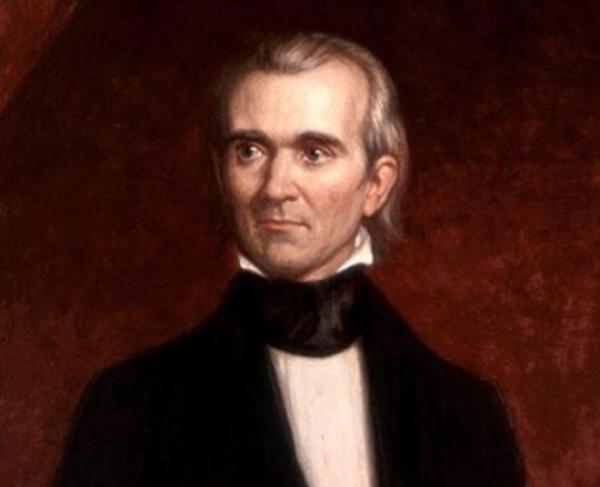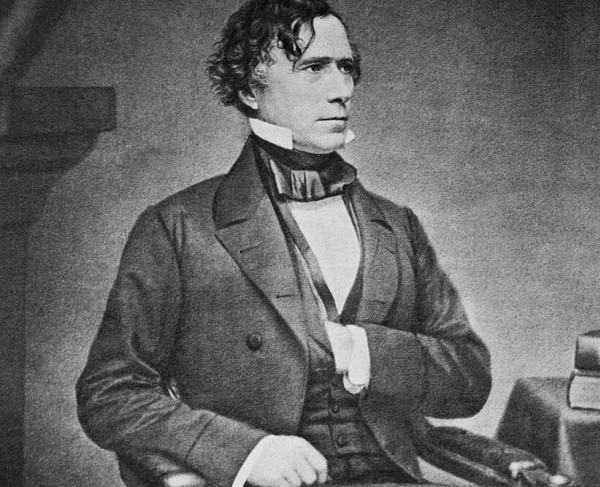James Polk

James K. Polk was born on November 2, 1795, in a log cabin in Mecklenburg County, North Carolina. The oldest of ten children, James moved to Middle Tennessee in 1806 when he was ten years old. As a sickly child, Polk was unable to participate in the rigors of farm life. Consequently, his father encouraged him to develop his mind and focus on his academics. James was a voracious reader and graduated first in his class from the University of North Carolina in 1818, which highlights his strong work ethic. Following his graduation, Polk passed the Tennessee bar and soon entered local and state politics.
In 1828, Polk was elected into the House of Representatives and served six terms there, including two as Speaker of the House. In 1839, Polk was elected as the ninth governor of Tennessee and served in that position for one term until 1841.
Andrew Jackson served as Polk’s mentor, and Polk’s nickname, “Young Hickory,” reflects the strong relationship between the two as Jackson's nickname was “Old Hickory.” Popular lore states that Jackson convinced Polk to pursue Sarah Childress, who later became his wife. They married in 1824 and became true partners. Mrs. Polk received an outstanding education and used her superb intelligence to support her husband’s career, often aiding him in political matters. Polk was a strong Jacksonian Democrat and absorbed most of Jackson’s ideology. Polk opposed banks and high tariffs and supported Native American removal and the extension of slavery. Polk himself was a slaveowner and co-owned a large cotton plantation with his brother. Polk did not waver from these core principles throughout his entire career.
As Jackson’s Vice President who later succeeded Jackson for the Presidency in 1836, Martin van Buren was considered to be Jackson’s successor who would instigate Jacksonian policy for years to come. However, van Buren was incredibly unpopular, mainly due to the Panic of 1837, which plunged the United States into a deep depression, lasting throughout van Buren’s term in office. Van Buren lost the Election of 1840 to William Henry Harrison, whose early death a month into office led him to be succeeded by John Tyler, an anti-Jacksonian Democrat masquerading as a Whig. Van Buren was the initial frontrunner for the Democratic nomination in 1844, where the main issue was Texas annexation; however, van Buren wrote an open letter where he opposed the annexation of Texas because it would open new slave territory and would cause war with Mexico. This ruined van Buren in the eyes of many Democrats, and they soon searched for a staunchly pro-annexationist candidate, which they found in Polk.
Polk supported the immediate annexation of Texas because he argued it was originally part of the Louisiana Purchase but was unjustly lost with the Adams-Onis Treaty of 1819. Polk ran on an expansionist platform where his main promises consisted of the annexation of Texas and the Oregon Territory. Not only did Polk believe in and support Manifest Destiny, he also held the belief that for slavery to survive, it needed to spread, which supported his expansionist principles.
In the Electoral College, Polk won by a landslide against Henry Clay, but won the popular vote by only 40,000 votes, a little over 1%. Nevertheless, on March 4, 1845, Polk was inaugurated as the 11th President of the United States. As President, Polk was an incredibly hard worker, often working at least 16-hour days. Polk only took four vacations in his four years in office and once called himself “the hardest working man in this country.” Polk’s strong work ethic paid off, in just four years in office he accomplished all his campaign promises. Polk lowered the protective tariff, renewed the Independent Treasury, won the Oregon Territory from England and brought New Mexico and California into the fold of the United States. However, the latter was achieved through the Mexican-American War, aptly nicknamed “Mr. Polk’s War.”
As his final action as President, John Tyler annexed Texas into the United States and would forever boast that it was he, not Polk, who managed to secure the annexation. However, this move angered Mexico and the movement of Zachary Taylor troops stationed in Louisiana to the Rio Grande in June 1845 only further increased tensions. In December 1845, Congress admitted Texas as the country’s 28th state, but this admission did not provoke immediate war. It is important to note that while Polk was a staunch expansionist, he took a more middle-of-the-road approach to United States expansion. Polk happily settled with the 49° parallel, instead of the 54°40’ line for Oregon’s border and he wanted the Rio Grande to be Texas’s southern boundary, not the Nueces. While Polk desired California and New Mexico, he did not want the United States to annex all of Mexico, which the more radical expansionists supported. Polk gained the Oregon Territory through successful negotiations with the British and wanted to do the same with California and New Mexico. However, by the time Polk dispatched commissioners to Mexico, the Mexican government willing to negotiate with the United States had been replaced with a government hostile to the US, who refused to negotiate and ruptured US-Mexican diplomatic relations in March 1846. By April, Polk and his administration wanted war, which Congress approved of on May 13, 1846. The hostilities lasted until February 2, 1848, with the Treaty of Guadalupe-Hildago. Under this treaty, the United States received the California and New Mexico territories, and the Rio Grande became Texas’s most southern border. In exchange for these 525 square miles of land, the United States paid Mexico $15 million cash and assumed Mexican debts (about $3.25 million). However, the war itself cost the United States nearly $100 million (more than $1 billion in today’s currency) and 12,000 Americans perished in Mexico. Ralph Waldo Emerson prophetically wrote, “Mexico will poison us” and although he didn’t know it at the time the territory gained from Mexico re-opened discussions over the extension of slavery into the territories and set off a series of events that increasingly heightened sectional tensions and ultimately led to the Civil War.
Polk elected not to run for a second term, thereby fulfilling an additional campaign promise. James Polk died on June 15, 1849, less than four months after leaving office, in Nashville, Tennessee of cholera. Many scholars agree that Polk practically worked himself to death while President; his four years in office exhausted him and destroyed his health. Polk died before he could see the bitter effects of his territory acquisition, mainly the Civil War, Mexico’s poison to the United States. However, despite this, President Polk still left positive influences on this country: his tariff reduction led to an economic boom in the late 1840s, and his treasury system lasted until 1913 when the establishment of the Federal Reserve replaced it. Polk remains one of our nation’s most hardworking presidents, and his early death attests to his strong work ethic. Through this work ethic, the United States was able to reach from sea to shining sea; however, the morality of which is still up for debate.


